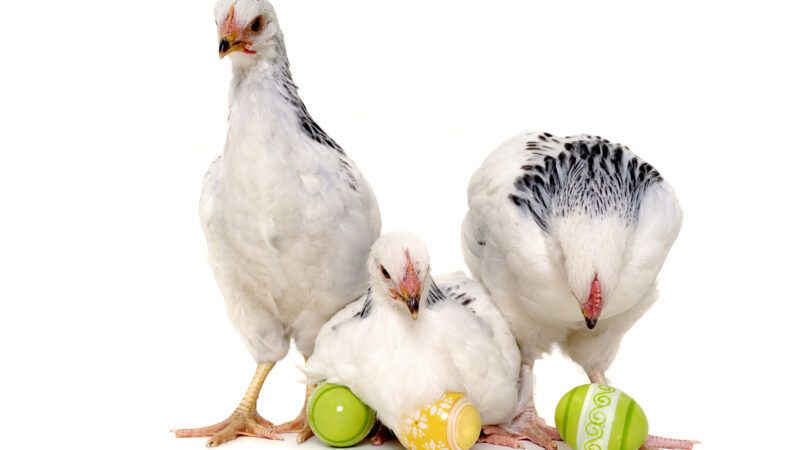Don't Fear the Bird Flu When Dyeing Easter Eggs
If you can afford them.

Dyeing eggs as part of the Easter celebration goes back at least as far as the Middle Ages, and perhaps earlier. Some 47 percent of Americans are, however, planning to forego this happy ritual this season, according to a survey by WalletHub. Why? Because eggs cost too damned much.
The rising per capita demand for eggs has contributed to higher prices for chicken ova, but the recent steep increase largely stems from outbreaks of H5N1 bird flu virus among commercial egg-laying flocks since 2022. The virus kills nearly 100 percent of infected domestic fowl. Once an infection is detected, the entire flock is culled to limit the spread of the virus. Since 2022, over 168 million chickens, ducks, and turkeys have been killed. Outbreaks have been detected among wild birds and commercial and backyard flocks in 681 counties in all 50 states.
Three years ago, before wild migratory birds began spreading the virus to domestic poultry, the wholesale price of eggs was just over $1 per dozen. That soared to over $8 per dozen in February 2025 but has since dropped to a little over $3 per dozen now. The shortage has abated somewhat as, despite the Trump administration's mad tariff shenanigans, the U.S. has imported eggs from Turkey, Brazil, and South Korea. Also, bird flu infections have recently receded a bit, allowing commercial producers to replenish their egg-laying flocks.
In an effort to boost egg supplies, some states are suspending their cage-free egg production mandates. While cage-free eggs cost more to produce, there is little evidence, however, that that production method has a significantly increased risk of bird flu infection compared to conventional production.
The most worrisome concern is that bird flu could mutate into a form that can readily infect mammals, including humans. So far bird flu outbreaks among dairy cattle have been detected in over 1,000 herds in 17 states. The virus has also infected a wide range of other mammals, including pet cats. The Centers for Disease Control and Prevention (CDC) reports that 70 people, mostly workers on dairy and poultry farms, have contracted the illness and only one has died. There have been no confirmed cases of human-to-human transmission. The current risk posed by H5N1 bird flu to public health is low, according to the CDC.
In March, Secretary of Health and Human Services (HHS) Robert F. Kennedy Jr. suggested that farmers let the virus "run through the flock[s]so that we can identify the birds, and preserve the birds, that are immune to it." One big problem: Every infected bird offers the flu virus another chance to mutate into a version that can be directly transmitted from person to person. In February, the U.S. Department of Agriculture conditionally approved a bird flu vaccine for use in poultry developed by animal care company Zoetis.
But never mind vaccines for chickens: The HHS should instead prioritize and support the development of human vaccines targeted at H5N1 flu viruses.
At any rate, there are no cases of anyone contracting bird flu from cooked eggs. So dyeing hard-boiled eggs for Easter is perfectly safe. That's good news for those who can afford them.
Editor's Note: As of February 29, 2024, commenting privileges on reason.com posts are limited to Reason Plus subscribers. Past commenters are grandfathered in for a temporary period. Subscribe here to preserve your ability to comment. Your Reason Plus subscription also gives you an ad-free version of reason.com, along with full access to the digital edition and archives of Reason magazine. We request that comments be civil and on-topic. We do not moderate or assume any responsibility for comments, which are owned by the readers who post them. Comments do not represent the views of reason.com or Reason Foundation. We reserve the right to delete any comment and ban commenters for any reason at any time. Comments may only be edited within 5 minutes of posting. Report abuses.
Please to post comments




I pay 2 dollars a dozen from a local farm, my last dozen had green, brown and white. and sometimes purple. I'm having steak and eggs on the Blackstone this morning.
Obese, obsolete, right-wing dead ends of evolution acting conceited about their ability to afford the most basic food supplies are among my favorite culture war casualties.
lol dumb commie faggot is dumb.
Barely verbal right-wing reject say what?
Lol. Way to pick your spots, rev. How devastating.
What an idiot.
Powerless convulsions of the soon to be gone. Triggered, seething, defeated. Carry on.
Our previous birds produced lovely bluish/green eggs. The next flock after that one was spent now all produce a far more dull brown egg.
Why do we not want to eliminate the disease by vaccinating the livestock known to carry it? That seems like a smarter path than waiting to vaccinate us against it once it mutates and jumps species. If we're concerned about the price of eggs and trying to avoid culling flocks then vaccinating the birds makes even more sense. The only limiting factor I can see is how expensive it might be to do so.
Nobody wants autistic chickens, that’s why.
I am pretty sure all poultry is on the spectrum.
Especially penguins.
Is this early phase propaganda for another "two weeks"? I mean, official claims of "nothing to worry about" coupled with all kinds of frightening and suggestive info would be how I start the disinformation campaign.
This would be over if these fucking chickens would practice social distancing and masking.
Stupid MAGA birds deserve to die!
More testing needed.
Yes to that. And more cowbell.
A pox on chicken journalism !
The Editors have laid ten ovolibertarian eggs before us since sunup Thurdsday
Yeah, $10 for a 12 ounce Starbucks chimney ash flavor latte is fine, but $6 for a dozen eggs is outrageous.
You pay extra at Starbucks for the earthy butthole taste.
Also, no stores near me have any eggs that cheap. They have come down, but they are still not that cheap.
Does no one at Reason know the price of eggs has come down an average of 55%?
Oh, right. Eggs will remain too expensive until Trump is gone.
Reason will of course toe the party line.